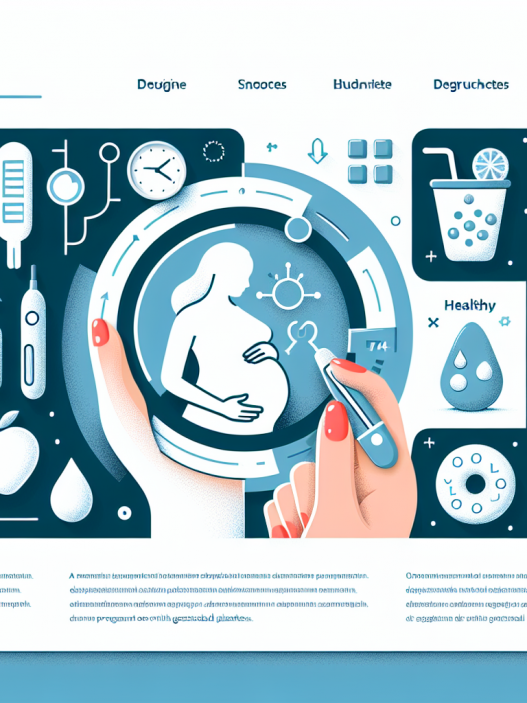[ad_1]
Gestational diabetes can be a challenging diagnosis during pregnancy, affecting not just your health but also that of your baby. Understanding how to manage this condition is crucial for maintaining a healthy pregnancy. In this comprehensive guide, we will explore effective strategies for living with gestational diabetes, offering insights into diet, exercise, and monitoring your blood sugar levels. Equip yourself with the knowledge you need for a healthier pregnancy.
Understanding Gestational Diabetes: Causes and Risk Factors
Gestational diabetes is a form of diabetes that occurs only during pregnancy. It typically develops in the second or third trimester when the body cannot produce enough insulin to support both the mother and the growing baby. The rise in hormones, particularly from the placenta, can inhibit the effectiveness of insulin, causing elevated blood glucose levels. While the exact cause of gestational diabetes isn’t fully understood, certain risk factors can increase the likelihood of developing this condition.
Women who are overweight or obese before pregnancy are at a higher risk. Age is another significant factor; women over 25 are more susceptible. Genetic predispositions also play a role—if gestational diabetes is common in your family, your risk increases. Additionally, women who have had gestational diabetes in previous pregnancies are likely to experience it again. Other factors, such as having polycystic ovary syndrome (PCOS) or a history of hypertension, can contribute to a higher risk. Understanding these factors is essential for early detection and effective management of gestational diabetes.
Maintaining a healthy lifestyle before and during pregnancy can significantly mitigate some of these risks. Balanced nutrition and regular physical activity can help regulate blood sugar levels, reducing the potential impact of gestational diabetes. Being proactive about your health can empower you to take control during this crucial time. By understanding your risks and taking preventive actions, you can enhance your chances of enjoying a healthy pregnancy.
Navigating Dietary Changes: Meal Planning for Gestational Diabetes
When living with gestational diabetes, one of the most critical aspects of management is adjusting your diet. Meal planning becomes essential to ensure you maintain stable blood glucose levels. The key to an effective meal plan is to focus on high-fiber, low-glycemic index foods. Incorporating whole grains, lean proteins, fruits, and vegetables into your meals can help you achieve this balance. It’s essential to limit the intake of processed foods, sugary snacks, and simple carbohydrates, which can lead to spikes in blood sugar.
When planning your meals, consider breaking them into smaller, more frequent portions spread throughout the day. This approach can help regulate your blood sugar levels more effectively than consuming three large meals. Aim to include a source of protein, healthy fats, and fiber in each meal or snack. For example, a meal of grilled chicken with roasted vegetables and quinoa offers a balanced combination that is satisfying and nutritious. Keep in mind that proper hydration is also an essential aspect of dietary management. Drinking adequate water can help regulate blood sugar levels and promote overall health.
Keep a food diary to track what you eat and how it affects your blood sugar levels. This practice can help you identify patterns and make better-informed decisions about your diet. Consulting with a registered dietitian can also be beneficial. They can help create a personalized meal plan that accommodates your preferences and lifestyle while ensuring you meet your nutritional needs throughout your pregnancy.
Exercise and Physical Activity: Enhancing Your Health
Incorporating regular exercise into your daily routine is vital for managing gestational diabetes. Physical activity helps your body use insulin more effectively and contributes to maintaining healthy blood sugar levels. Aim for at least 150 minutes of moderate-intensity exercise each week. Activities such as brisk walking, swimming, and prenatal yoga are excellent options for pregnant women.
Engaging in consistent physical activity offers numerous benefits beyond blood sugar management. Regular exercise can help alleviate common pregnancy discomforts, improve mood, and enhance your energy levels. Additionally, staying active can prepare your body for labor and delivery, making the experience smoother and more manageable. Always consult with your healthcare provider before starting any new exercise program, especially if you have been inactive or have any health concerns.
Listening to your body is crucial while exercising during pregnancy. If you experience any unusual symptoms, such as shortness of breath, dizziness, or swelling, it’s essential to stop and consult your doctor. Focus on low-impact exercises that are safe for your condition, and consider incorporating strength training exercises to build endurance. Finding a workout buddy or joining a prenatal exercise class can provide motivation and support, making it easier to maintain consistency in your exercise routine.
Monitoring Blood Sugar Levels: Essential Practices
Regular monitoring of your blood sugar levels is a crucial element in managing gestational diabetes. Your healthcare provider will likely recommend testing your blood glucose at specific times throughout the day, such as before meals and two hours after eating. This routine helps you understand how your body responds to different foods and activities. Keeping a small logbook or using a blood sugar tracking app can simplify this process, allowing you to track trends and share your findings with your healthcare team.
There are different methods for blood sugar monitoring, and your healthcare provider can guide you on which device is best for you. Continuous glucose monitors (CGMs) are increasingly popular for their convenience, providing real-time data on glucose levels. This technology helps you respond immediately to any fluctuations in your levels, allowing for better overall management of your condition.
Responding appropriately to your blood sugar readings is essential. If you notice high blood sugar levels after certain meals, consider adjusting your dietary choices or portion sizes. Conversely, if you experience low blood sugar levels, make sure to consume small, balanced snacks to help stabilize your glucose levels. Understanding your individual patterns and needs will empower you to make informed decisions that support your pregnancy and your baby’s health.
Communicating with Healthcare Providers: Building a Support System
Maintaining open communication with your healthcare team is vital when managing gestational diabetes. Regular check-ups and monitoring are crucial for ensuring that both you and your baby are healthy. Such visits give you an opportunity to discuss your concerns, ask questions, and update your healthcare provider about your progress. Don’t hesitate to speak up if you feel unsure or overwhelmed—your healthcare team is there to support you.
Consider creating a healthcare plan that outlines your specific treatment goals, dietary preferences, and monitoring routines. This document can serve as a reference point during appointments and facilitate straightforward discussions with your provider. Sharing your food diary or blood sugar logs during consultations can provide valuable insights for your healthcare team, allowing them to adjust your care plan as needed.
It’s also essential to seek emotional support from family and friends. Living with gestational diabetes can be stressful, and having a solid support network can ease anxiety and foster a more positive experience. Whether it’s joining a support group for expectant mothers with diabetes or simply confiding in a trusted friend, connecting with others who understand your journey can provide relief and motivation.
Preparing for Labor and Delivery: Special Considerations
As you approach labor and delivery, it’s essential to consider how gestational diabetes may impact your experience. Your healthcare provider will likely monitor both your and your baby’s health closely in the weeks leading up to your delivery date. Regular ultrasounds may be done to assess the baby’s growth and well-being, as some babies born to mothers with gestational diabetes may be larger than average (macrosomia). This condition can influence the type of delivery you have, so it’s important to have a candid discussion with your doctor about your delivery plan.
Understanding the signs of labor and when to contact your healthcare provider is critical. Because gestational diabetes can lead to potential complications, such as preeclampsia, it’s essential to remain vigilant. Keeping a list of emergency contacts and being well-informed about your birth plan can help alleviate stress as you prepare for labor. Furthermore, consider discussing with your healthcare team about the possibility of needing a cesarean section if labor does not progress as expected.
After delivery, your healthcare team will continue to monitor you closely, as gestational diabetes often resolves after giving birth. However, some women may develop type 2 diabetes later in life. Regular post-pregnancy check-ups, including glucose testing, are vital for tracking any changes in your health and ensuring ongoing wellness.
Conclusion
Living with gestational diabetes may seem daunting, but with the right strategies and support system in place, you can achieve a healthy pregnancy. By understanding the condition, making informed dietary choices, engaging in physical activity, and maintaining open communication with your healthcare providers, you can successfully navigate this chapter of your life. Remember to listen to your body, advocate for your health, and celebrate the milestones along the way, as you and your baby deserve the best start possible.
[ad_2]





















